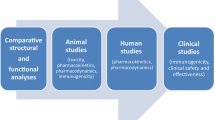Abstract
To demonstrate a biological product is biosimilar to a reference product, the applicant needs to show that the product is highly similar and has no clinically meaningful differences. Comparative clinical studies are often conducted to support the conclusion of no clinically meaningful differences, as a part of totality of evidence. The FDA has published several guidance documents to facilitate the development of biosimilar products. While the guidance documents define the role and objective of comparative clinical studies, they do not provide details about the determination of the similarity margin. In this paper, we illustrate a similarity margin derivation for a surrogate endpoint in comparative clinical studies conducted to assess whether clinically meaningful differences exist between Neupogen® (Filgrastim, granulocyte colony-stimulating factor) and products proposed to be biosimilar to Neupogen®.

Similar content being viewed by others
References
FDA. Scientific Considerations in Demonstrating Biosimilarity to a Reference Product. 2015. https://www.fda.gov/downloads/Drugs/GuidanceComplianceRegulatoryInformation/Guidances/UCM291128.pdf. Accessed 28 Dec 2017.
Panopoulos AD, Watowich SS. Granulocyte colony-stimulating factor: molecular mechanisms of action during steady state and ‘emergency’ hematopoiesis. Cytokine. 2008;42(3):277–88.
Greenbaum AM, Link DC. Mechanisms of G-CSF-mediated hematopoietic stem and progenitor mobilization. Leukemia. 2011;25(2):211–7.
Bugl S, Wirths S, Muller MR, Radsak MP, Kopp HG. Current insights into neutrophil homeostasis. Ann N Y Acad Sci. 2012;1266:171–8.
Wirths S, Bugl S, Kopp HG. Steady-state neutrophil homeostasis is a demand-driven process. Cell Cycle. 2013;12(5):709–10.
Berger RL, Hsu JC. Bioequivalence trials, intersection-union tests and equivalence confidence sets. Stat Sci. 1996;11(4):283–302.
FDA. Neupogen review. 1991. https://www.accessdata.fda.gov/drugsatfda_docs/bla/pre96/103353Orig1s000.pdf.
FDA. FDA Briefing Document: EP2006, a proposed biosimilar to Neupogen. 2015. http://wayback.archiveit.org/7993/20170114013309/http://www.fda.gov/downloads/AdvisoryCommittees/CommitteesMeetingMaterials/Drugs/OncologicDrugsAdvisoryCommittee/UCM472968.pdf.
FDA. Clinical review for Neulasta approval. 2002. https://www.accessdata.fda.gov/drugsatfda_docs/nda/2002/125031_0000_NeulastaTOC.cfm.
Crawford J, Ozer H, Stoller R, Johnson D, Lyman G, Tabbara I, et al. Reduction by granulocyte colony-stimulating factor of fever and neutropenia induced by chemotherapy in patients with small-cell lung cancer. N Engl J Med. 1991;325(3):164–70.
FDA. Neupogen Label. 1998. https://www.accessdata.fda.gov/drugsatfda_docs/label/1998/filgamg040298lb.pdf. Accessed 14 Dec 2017.
Del Giglio A, Eniu A, Ganea-Motan D, Topuzov E, Lubenau H. XM02 is superior to placebo and equivalent to Neupogen in reducing the duration of severe neutropenia and the incidence of febrile neutropenia in cycle 1 in breast cancer patients receiving docetaxel/doxorubicin chemotherapy. BMC Cancer. 2008;8:332.
Timmer-Bonte JN, de Boo TM, Smit HJ, Biesma B, Wilschut FA, Cheragwandi SA, et al. Prevention of chemotherapy-induced febrile neutropenia by prophylactic antibiotics plus or minus granulocyte colony-stimulating factor in small-cell lung cancer: a Dutch Randomized Phase III Study. J Clin Oncol. 2005;23(31):7974–84.
FDA. Neulasta label. 2002. https://www.accessdata.fda.gov/drugsatfda_docs/label/2002/filgamg052902LB.pdf. Accessed 28 Dec 2017.
FDA. Guidance for industry: Non-Inferiority Clinical Trials to Establish Effectiveness. 2016. https://www.fda.gov/downloads/Drugs/Guidances/UCM202140.pdf. Accessed 28 Dec 2017.
Acknowledgements
The authors thank Dr Leah Christl, Dr Shein-Chung Chow, and three reviewers for their very helpful comments and suggestions.
Author information
Authors and Affiliations
Corresponding author
Ethics declarations
Funding
No external funding was used in the preparation of this manuscript.
Conflict of interest
Authors L. Nie, D. Przepiorka, A. Deisseroth, R. Sridhara, and T. E. Gwise declare that they have no conflicts of interest that might be relevant to the contents of this manuscript.
Additional information
Disclaimer: This article reflects the views of the authors and should not be construed to represent the views or policies of the FDA.
Rights and permissions
About this article
Cite this article
Nie, L., Przepiorka, D., Deisseroth, A. et al. Determination of Similarity Margin in Comparative Clinical Studies to Support the Development of Biosimilar Products of Neupogen® (Filgrastim, Granulocyte Colony-Stimulating Factor [G-CSF]). BioDrugs 32, 325–330 (2018). https://doi.org/10.1007/s40259-018-0288-z
Published:
Issue Date:
DOI: https://doi.org/10.1007/s40259-018-0288-z




